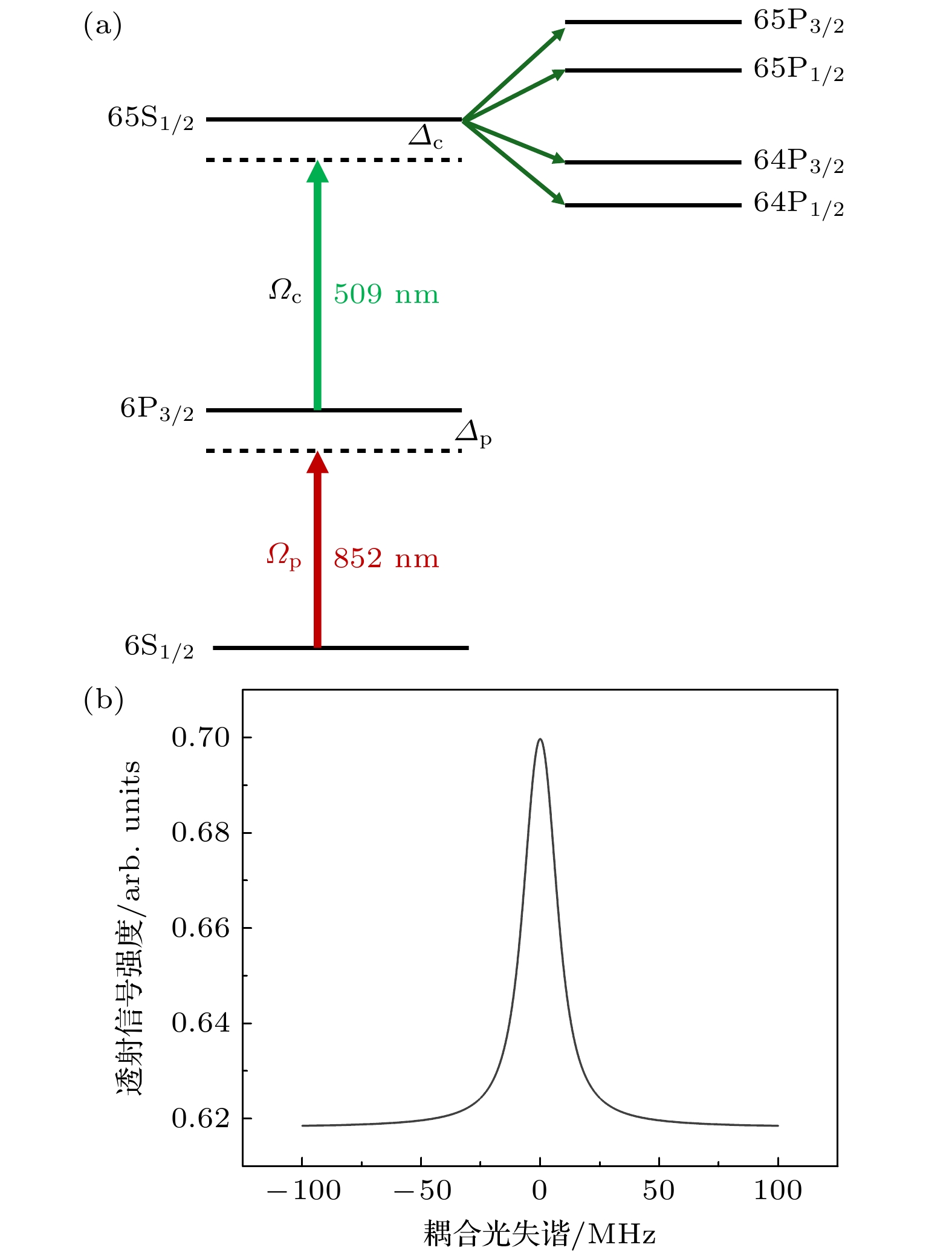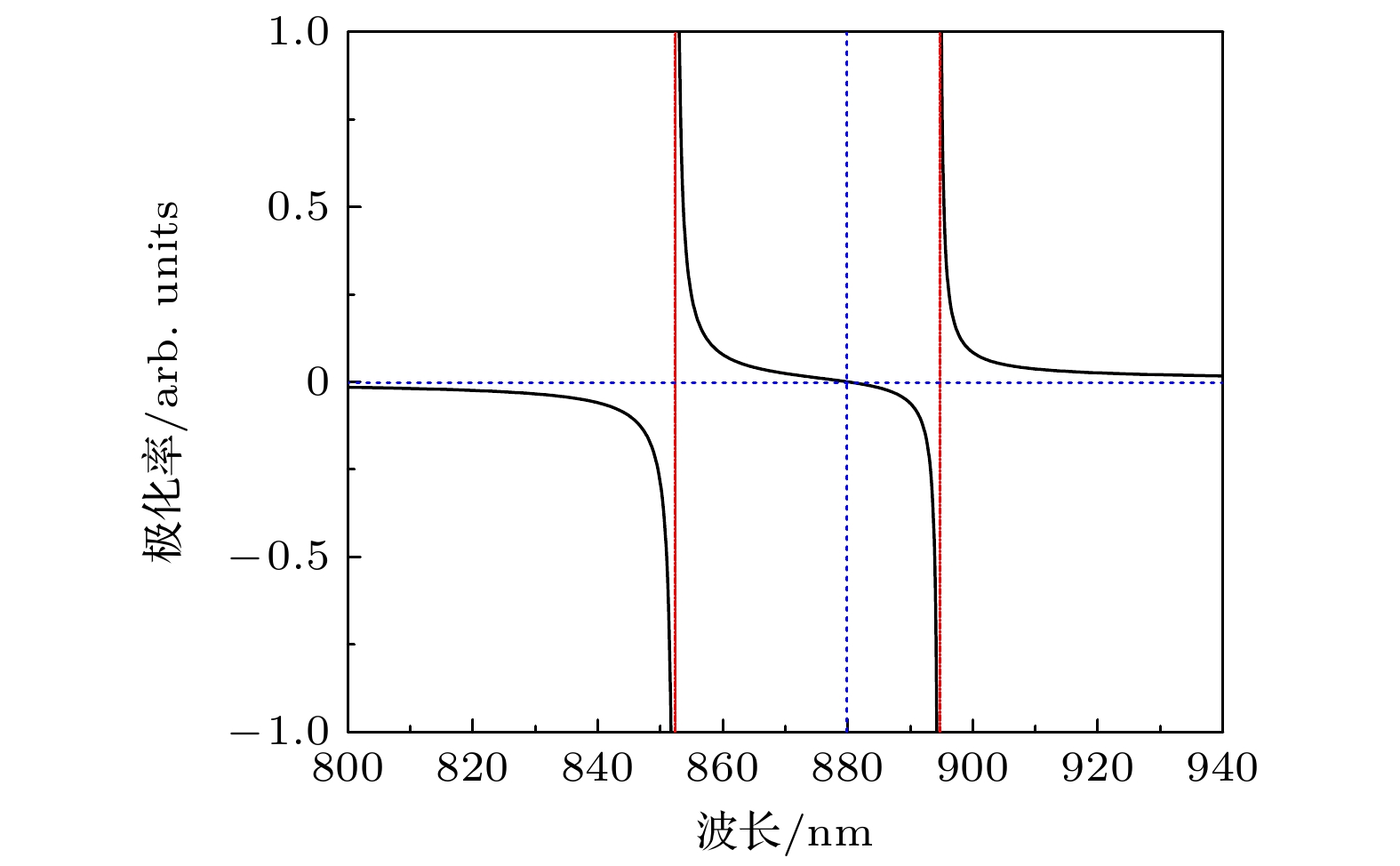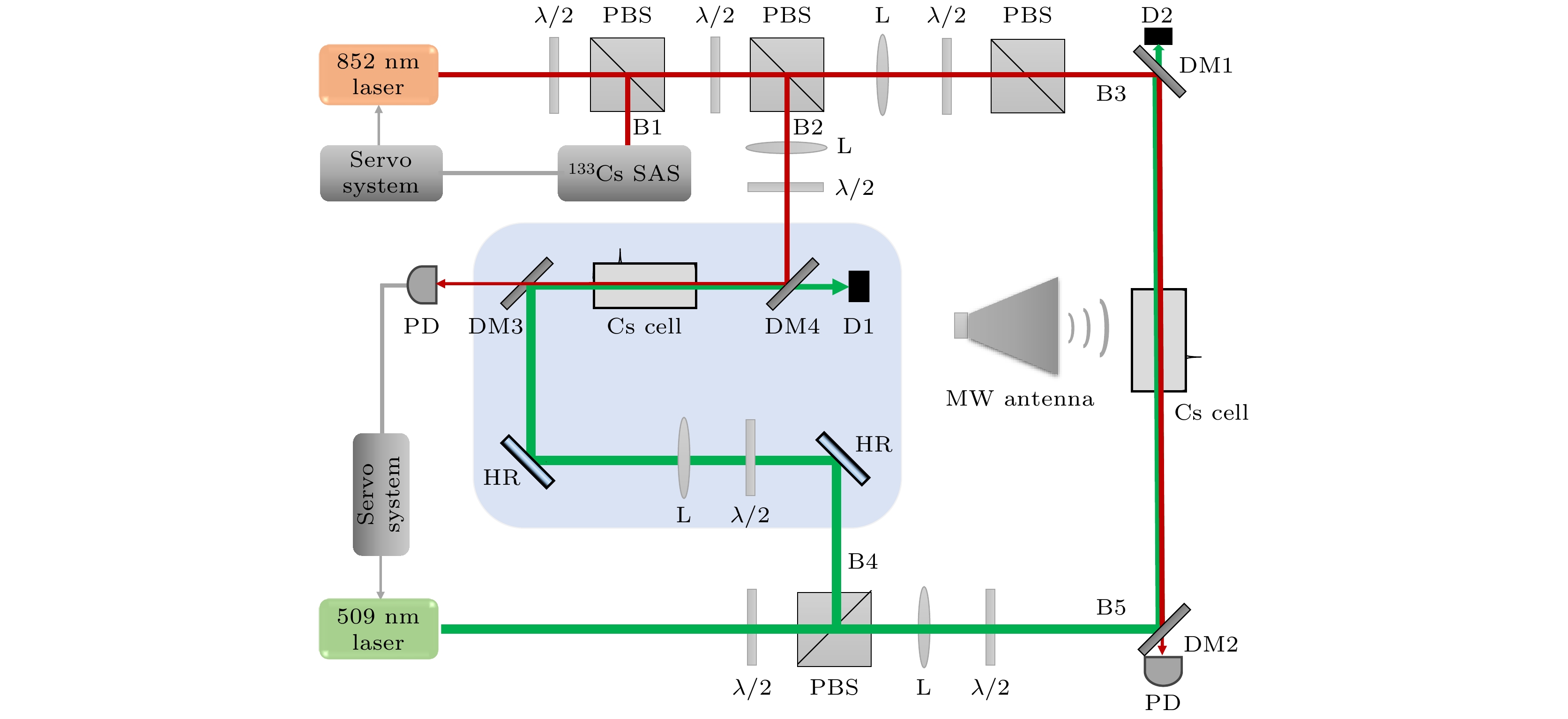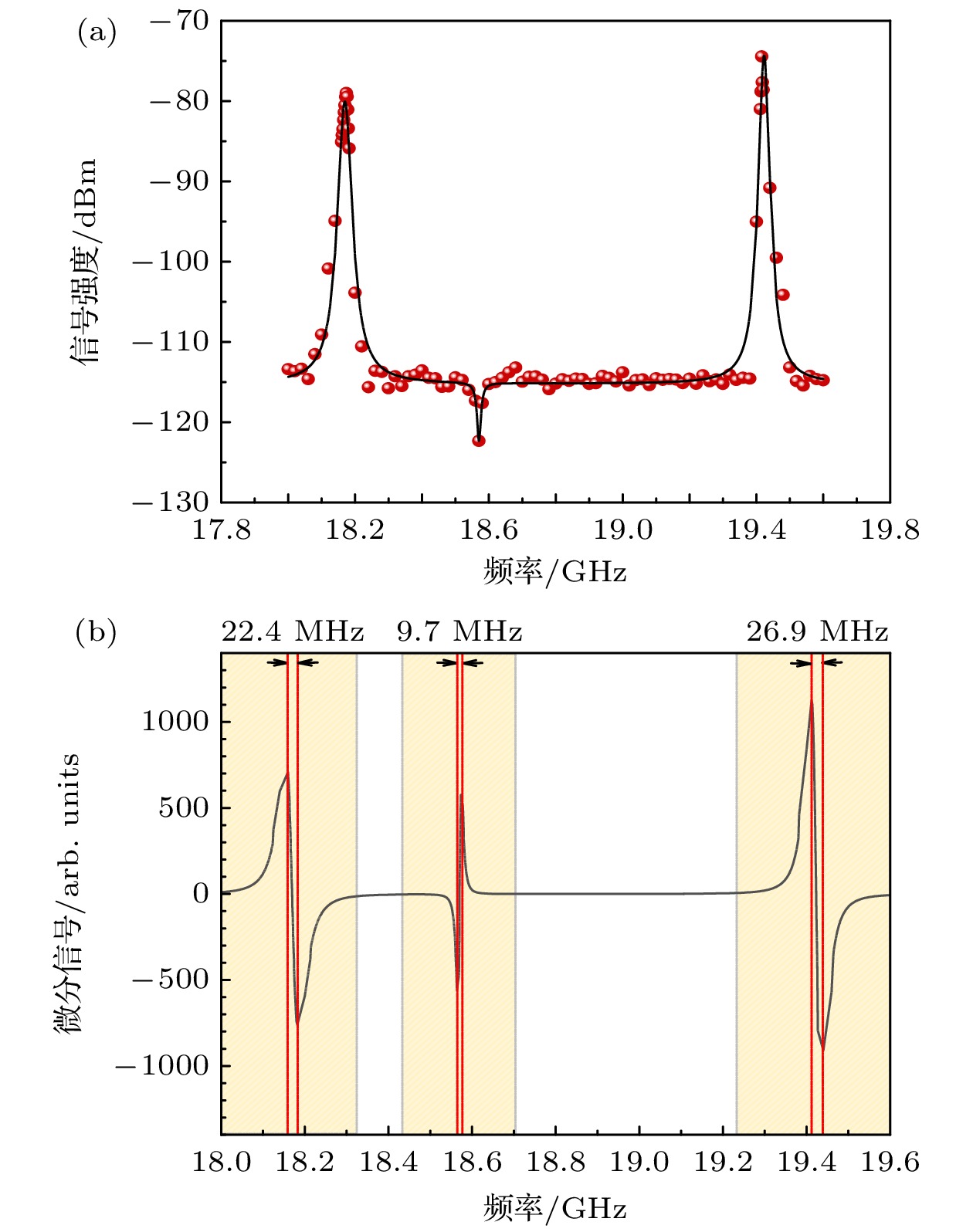-
The atomic polarizability represents the response characteristics of atoms to externally applied electro-magnetic fields. The wavelength (or frequency) at which the dynamic polarizability of an atom is equal to zero is referred to as the tune-out wavelength (or frequency). Spectroscopy technology based on the tune-out effect has potential applications in quantum precision measurement, quantum computation and quantum communication. Related research topics include the measurement of fundamental physical constants and strong interactions. The tune-out wavelengths of atoms in low-lying states primarily fall within the optical band, where the theoretical calculations and experimental measurements have significant progress. However, for Rydberg atoms in highly excited states, theoretical calculations are challenging due to their high density of atomic states. The difficulty of experimental measurement arises from small splitting of adjacent atomic energy levels. In this paper, we demonstrate the tune-out wavelengths measurement for Rydberg atoms in a cesium vapor cell at room temperature. We utilize a two-photon cascade excitation to prepare Rydberg states and employ amplitude-modulation electromagnetically-induced transparency (AM-EIT) spectroscopy to measure the tune-out wavelength. By continuously scanning the microwave frequencies, we obtain AM-EIT signals of Rydberg atoms. At near-resonant microwave transition wavelengths, strong AM-EIT signals are observed due to microwave-atom coupling. Conversely, at tune-out wavelengths, the dynamically polarization-induced destructive interference in neighboring energy states occurs which leads to the weak AM-EIT signals. The AM-EIT provides a spectral resolution of about 10 MHz. We have developed a simplified three-level model to calculate the tune-out wavelength. The results of our theoretical calculations are consistent with the experimental findings within a range of ±90 MHz.
-
Keywords:
- Rydberg atom /
- cesium atoms /
- electromagnetically induced transparency spectrum /
- tune-out wavelength
[1] Scheffers H, Stark J 1934 Phys. Z. 35 625
[2] Holmgren W F, Trubko R, Hromada I, Cronin A D 2012 Phys. Rev. Lett. 109 243004
 Google Scholar
Google Scholar
[3] Leonard R H, Fallon A J, Sackett C A, Safronova M S 2015 Phys. Rev. A 92 052501
 Google Scholar
Google Scholar
[4] Arora B, Safronova M S, Clark C W 2011 Phys. Rev. A 84 043401
 Google Scholar
Google Scholar
[5] Schmidt F, Mayer D, Hohmann M, Lausch T, Kindermann F, Widera A 2016 Phys. Rev. A 93 022507
 Google Scholar
Google Scholar
[6] Jefferts S R, Heavner T P, Parker T E, Shirley J H, Donley E A, Ashby N, Levi F, Calonico D, Costanzo G A 2014 Phys. Rev. Lett. 112 050801
 Google Scholar
Google Scholar
[7] Wang Y, Zhang X L, Corcovilos T A, Kumar A, Weiss D S 2015 Phys. Rev. Lett. 115 043003
 Google Scholar
Google Scholar
[8] Herold C D, Vaidya V D, Li X, Rolston S L, Porto J V, Safronova M S 2012 Phys. Rev. Lett. 109 243003
 Google Scholar
Google Scholar
[9] Safronova M S, Zuhrianda Z, Safronova U I, Clark C W 2015 Phys. Rev. A 92 040501
 Google Scholar
Google Scholar
[10] Fallon A, Sackett C 2016 Atoms 4 12
 Google Scholar
Google Scholar
[11] LeBlanc L J, Thywissen J H 2007 Phys. Rev. A 75 053612
 Google Scholar
Google Scholar
[12] Mitroy J, Tang L Y 2013 Phys. Rev. A 88 052515
 Google Scholar
Google Scholar
[13] Henson B M, Khakimov R I, Dall R G, Baldwin K G H, Tang L Y, Truscott A G 2015 Phys. Rev. Lett. 115 043004
 Google Scholar
Google Scholar
[14] Leonard R H, Fallon A J, Sackett C A, Safronova M S 2017 Phys. Rev. A 95 059901
 Google Scholar
Google Scholar
[15] Zhang Y H, Tang L Y, Zhang X Z, Shi T Y 2016 Phys. Rev. A 93 052516
 Google Scholar
Google Scholar
[16] Lai Z L, Zhang S C, Gou Q D, Li Y 2018 Phys. Rev. A 98 052503
 Google Scholar
Google Scholar
[17] Zhang Y H, Wu F F, Zhang P P, Tang L Y, Zhang J Y, Baldwin K G H, Shi T Y 2019 Phys. Rev. A 99 040502
 Google Scholar
Google Scholar
[18] Copenhaver E, Cassella K, Berghaus R, Müller H 2019 Phys. Rev. A 100 063603
 Google Scholar
Google Scholar
[19] Jiang J, Li X J, Wang X, Dong C Z, Wu Z W 2020 Phys. Rev. A 102 042823
 Google Scholar
Google Scholar
[20] 李贤君 2020 硕士学位论文 (兰州: 西北师范大学)
Li X J 2020 M. S. Thesis (Lanzhou: Northwest Normal University
[21] Henson B M, Ross J A, Thomas K F, Kuhn C N, Shin D K, Hodgman S S, Zhang Y H, Tang L Y, Drake G W F, Bondy A T, Truscott A G, Baldwin K G H 2022 Science 376 199
 Google Scholar
Google Scholar
[22] Orcutt R H, Cole R H 1967 J. Chem. Phys. 46 697
 Google Scholar
Google Scholar
[23] Molof R W, Schwartz H L, Miller T M, Bederson B 1974 Phys. Rev. A 10 1131
 Google Scholar
Google Scholar
[24] Mille T M, Bederson B 1976 Phys. Rev. A 14 1572
 Google Scholar
Google Scholar
[25] Schwartz H L, Miller T M, Bederson B 1974 Phys. Rev. A 10 1924
 Google Scholar
Google Scholar
[26] Cronin A D, Schemiedmayer J, Pritchard D E 2009 Rev. Mod. Phys. 81 1051
 Google Scholar
Google Scholar
[27] Miffre A, Jacquet M, Büchner M, Trénec G, Vigué J 2006 Eur. Phys. J. D 38 353
 Google Scholar
Google Scholar
[28] Ekstrom C R, Schmiedmayer J, Chapman M S, Hammond T D, Pritchard D E 1995 Phys. Rev. A 51 3883
 Google Scholar
Google Scholar
[29] Holmgren W F, Revelle M C, Lonij V P A, Cronin A D 2010 Phys. Rev. A 81 053607
 Google Scholar
Google Scholar
[30] Gregoire M D, Hromada I, Holmgren W F, Trubko R, Cronin A D 2015 Phys. Rev. A 92 052513
 Google Scholar
Google Scholar
[31] Amini J M, Gould H 2003 Phys. Rev. Lett. 91 153001
 Google Scholar
Google Scholar
[32] Ratkata A, Gregory P D, Innes A D, Matthies A J, McArd L A, Mortlock J M, Safronova M S, Bromley S L, Cornish S L 2021 Phys. Rev. A 104 052813
 Google Scholar
Google Scholar
-
图 2 (a) 铯原子里德伯能级; (b) 基于阶梯型多能级结构理论模拟EIT光谱. 横坐标为耦合光失谐, 纵坐标为EIT透射信号强度
Figure 2. (a) In the first part, schematic of a three-level Rydberg atom system with a ground state $\left| {6{{\text{S}}_{{1 \mathord{\left/ {\vphantom {1 2}} \right. } 2}}}} \right\rangle $, an intermediate state $\left| {6{{\text{P}}_{{3 \mathord{\left/ {\vphantom {3 2}} \right. } 2}}}} \right\rangle $, and an excited state $\left| {65{{\text{S}}_{{1 \mathord{\left/ {\vphantom {1 2}} \right. } 2}}}} \right\rangle $. A weak probe laser couples $\left| {6{{\text{S}}_{{1 \mathord{\left/ {\vphantom {1 2}} \right. } 2}}}} \right\rangle $ with $\left| {6{{\text{P}}_{{3 \mathord{\left/ {\vphantom {3 2}} \right. } 2}}}} \right\rangle $ for Rabi frequency ${\varOmega _{\text{p}}}$ and a strong coupling laser couples $\left| {6{{\text{P}}_{{3 \mathord{\left/ {\vphantom {3 2}} \right. } 2}}}} \right\rangle $ with $\left| {65{{\text{S}}_{{1 \mathord{\left/ {\vphantom {1 2}} \right. } 2}}}} \right\rangle $ for Rabi frequency ${\varOmega _{\text{c}}}$. ${\varDelta _{\text{p}}}$ and $ {\varDelta _{\text{c}}} $ are the laser detuning of the probe and coupling lasers, respectively. In part two, The four microwave transitions adjacent to Rydberg state $\left| {65{{\text{S}}_{{1 \mathord{\left/ {\vphantom {1 2}} \right. } 2}}}} \right\rangle $ are $65{{\text{S}}_{{1 \mathord{\left/ {\vphantom {1 2}} \right. } 2}}} \to 64{{\text{P}}_{{1 \mathord{\left/ {\vphantom {1 2}} \right. } 2}}}$, $65{{\text{S}}_{{1 \mathord{\left/ {\vphantom {1 2}} \right. } 2}}} \to 64{{\text{P}}_{{3 \mathord{\left/ {\vphantom {3 2}} \right. } 2}}}$, $ 65{{\text{S}}_{{1 \mathord{\left/ {\vphantom {1 2}} \right. } 2}}} \to 65{{\text{P}}_{{1 \mathord{\left/ {\vphantom {1 2}} \right. } 2}}} $, $65{{\text{S}}_{{1 \mathord{\left/ {\vphantom {1 2}} \right. } 2}}} \to 65{{\text{P}}_{{3 \mathord{\left/ {\vphantom {3 2}} \right. } 2}}}$; (b) transmission of the probe laser as the function of the coupling laser detuning.
图 4 铯原子光谱实验装置图. λ/2, 半波片; PBS, 偏振分光棱镜; L, 透镜; DM1, DM4, 852 nm高反射率(HR)和509 nm高透射率(HT)双色镜; DM2, DM3, 852 nm高透射率(HT)和509 nm高反射率(HR)双色镜; PD, 光电探测器; SAS, 饱和吸收光谱; D, 激光收集器
Figure 4. Experimental set-up. λ/2, half-wave plate; PBS, polarizing beam splitter cube; L, lens; DM1, DM4, 852 nm high reflectivity (HR) and 509 nm high transmissivity (HT) dichroic mirror; DM2, DM3, 852 nm high transmissivity (HT) and 509 nm high reflectivity (HR) dichroic mirror; PD, photodiode; SAS, saturation absorption spectroscopy; D, optical dump.
图 5 (a) 里德伯态$\left| {65{{\text{S}}_{{1 \mathord{\left/ {\vphantom {1 2}} \right. } 2}}}} \right\rangle $对应微波共振跃迁及tune-out光谱; (b) 理论计算$65{{\text{S}}_{{1 \mathord{\left/ {\vphantom {1 2}} \right. } 2}}} \to 64{{\text{P}}_{{3 \mathord{\left/ {\vphantom {3 2}} \right. } 2}}}$, $65{{\text{S}}_{{1 \mathord{\left/ {\vphantom {1 2}} \right. } 2}}} \to 65{{\text{P}}_{{3 \mathord{\left/ {\vphantom {3 2}} \right. } 2}}}$跃迁对应tune-out波长
Figure 5. (a) Microwave resonance transitions and tune-out spectrum of Rydberg state $\left| {65{{\text{S}}_{{1 \mathord{\left/ {\vphantom {1 2}} \right. } 2}}}} \right\rangle $; (b) theoretical calculation of the tune-out wavelength between the two transitions, $65{{\text{S}}_{{1 \mathord{\left/ {\vphantom {1 2}} \right. } 2}}} \to 64{{\text{P}}_{{3 \mathord{\left/ {\vphantom {3 2}} \right. } 2}}} $ and $ 65{{\text{S}}_{{1 \mathord{\left/ {\vphantom {1 2}} \right. } 2}}} \to 65{{\text{P}}_{{3 \mathord{\left/ {\vphantom {3 2}} \right. } 2}}}$.
图 6 (a) $\left| {60{{\text{S}}_{{1 \mathord{\left/ {\vphantom {1 2}} \right. } 2}}}} \right\rangle $里德伯态对应微波共振跃迁及tune-out光谱; (b) $\left| {60{{\text{S}}_{{1 \mathord{\left/ {\vphantom {1 2}} \right. } 2}}}} \right\rangle $里德伯态共振跃迁及tune-out光谱的微分信号
Figure 6. (a) Microwave resonance transitions and tune-out spectrum of Rydberg state $\left| {60{{\text{S}}_{{1 \mathord{\left/ {\vphantom {1 2}} \right. } 2}}}} \right\rangle $; (b) differential signals of Rydberg state resonance transitions and tune-out spectrum.
-
[1] Scheffers H, Stark J 1934 Phys. Z. 35 625
[2] Holmgren W F, Trubko R, Hromada I, Cronin A D 2012 Phys. Rev. Lett. 109 243004
 Google Scholar
Google Scholar
[3] Leonard R H, Fallon A J, Sackett C A, Safronova M S 2015 Phys. Rev. A 92 052501
 Google Scholar
Google Scholar
[4] Arora B, Safronova M S, Clark C W 2011 Phys. Rev. A 84 043401
 Google Scholar
Google Scholar
[5] Schmidt F, Mayer D, Hohmann M, Lausch T, Kindermann F, Widera A 2016 Phys. Rev. A 93 022507
 Google Scholar
Google Scholar
[6] Jefferts S R, Heavner T P, Parker T E, Shirley J H, Donley E A, Ashby N, Levi F, Calonico D, Costanzo G A 2014 Phys. Rev. Lett. 112 050801
 Google Scholar
Google Scholar
[7] Wang Y, Zhang X L, Corcovilos T A, Kumar A, Weiss D S 2015 Phys. Rev. Lett. 115 043003
 Google Scholar
Google Scholar
[8] Herold C D, Vaidya V D, Li X, Rolston S L, Porto J V, Safronova M S 2012 Phys. Rev. Lett. 109 243003
 Google Scholar
Google Scholar
[9] Safronova M S, Zuhrianda Z, Safronova U I, Clark C W 2015 Phys. Rev. A 92 040501
 Google Scholar
Google Scholar
[10] Fallon A, Sackett C 2016 Atoms 4 12
 Google Scholar
Google Scholar
[11] LeBlanc L J, Thywissen J H 2007 Phys. Rev. A 75 053612
 Google Scholar
Google Scholar
[12] Mitroy J, Tang L Y 2013 Phys. Rev. A 88 052515
 Google Scholar
Google Scholar
[13] Henson B M, Khakimov R I, Dall R G, Baldwin K G H, Tang L Y, Truscott A G 2015 Phys. Rev. Lett. 115 043004
 Google Scholar
Google Scholar
[14] Leonard R H, Fallon A J, Sackett C A, Safronova M S 2017 Phys. Rev. A 95 059901
 Google Scholar
Google Scholar
[15] Zhang Y H, Tang L Y, Zhang X Z, Shi T Y 2016 Phys. Rev. A 93 052516
 Google Scholar
Google Scholar
[16] Lai Z L, Zhang S C, Gou Q D, Li Y 2018 Phys. Rev. A 98 052503
 Google Scholar
Google Scholar
[17] Zhang Y H, Wu F F, Zhang P P, Tang L Y, Zhang J Y, Baldwin K G H, Shi T Y 2019 Phys. Rev. A 99 040502
 Google Scholar
Google Scholar
[18] Copenhaver E, Cassella K, Berghaus R, Müller H 2019 Phys. Rev. A 100 063603
 Google Scholar
Google Scholar
[19] Jiang J, Li X J, Wang X, Dong C Z, Wu Z W 2020 Phys. Rev. A 102 042823
 Google Scholar
Google Scholar
[20] 李贤君 2020 硕士学位论文 (兰州: 西北师范大学)
Li X J 2020 M. S. Thesis (Lanzhou: Northwest Normal University
[21] Henson B M, Ross J A, Thomas K F, Kuhn C N, Shin D K, Hodgman S S, Zhang Y H, Tang L Y, Drake G W F, Bondy A T, Truscott A G, Baldwin K G H 2022 Science 376 199
 Google Scholar
Google Scholar
[22] Orcutt R H, Cole R H 1967 J. Chem. Phys. 46 697
 Google Scholar
Google Scholar
[23] Molof R W, Schwartz H L, Miller T M, Bederson B 1974 Phys. Rev. A 10 1131
 Google Scholar
Google Scholar
[24] Mille T M, Bederson B 1976 Phys. Rev. A 14 1572
 Google Scholar
Google Scholar
[25] Schwartz H L, Miller T M, Bederson B 1974 Phys. Rev. A 10 1924
 Google Scholar
Google Scholar
[26] Cronin A D, Schemiedmayer J, Pritchard D E 2009 Rev. Mod. Phys. 81 1051
 Google Scholar
Google Scholar
[27] Miffre A, Jacquet M, Büchner M, Trénec G, Vigué J 2006 Eur. Phys. J. D 38 353
 Google Scholar
Google Scholar
[28] Ekstrom C R, Schmiedmayer J, Chapman M S, Hammond T D, Pritchard D E 1995 Phys. Rev. A 51 3883
 Google Scholar
Google Scholar
[29] Holmgren W F, Revelle M C, Lonij V P A, Cronin A D 2010 Phys. Rev. A 81 053607
 Google Scholar
Google Scholar
[30] Gregoire M D, Hromada I, Holmgren W F, Trubko R, Cronin A D 2015 Phys. Rev. A 92 052513
 Google Scholar
Google Scholar
[31] Amini J M, Gould H 2003 Phys. Rev. Lett. 91 153001
 Google Scholar
Google Scholar
[32] Ratkata A, Gregory P D, Innes A D, Matthies A J, McArd L A, Mortlock J M, Safronova M S, Bromley S L, Cornish S L 2021 Phys. Rev. A 104 052813
 Google Scholar
Google Scholar
Catalog
Metrics
- Abstract views: 5534
- PDF Downloads: 131
- Cited By: 0















 DownLoad:
DownLoad:





